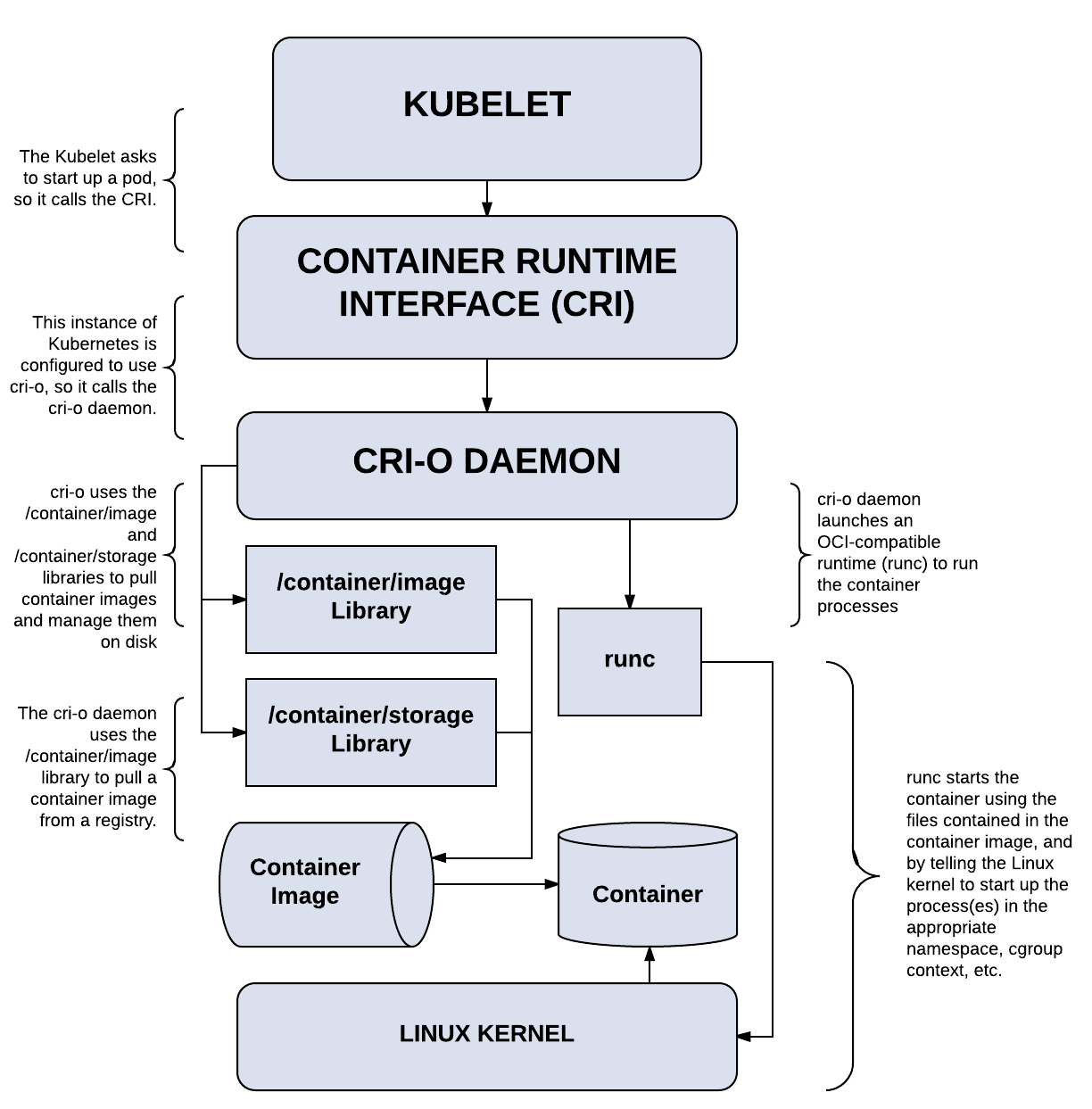Last year, the Kubernetes project introduced its Container Runtime Interface (CRI) -- a plugin interface that gives kubelet (a cluster node agent used to create pods and start containers) the ability to use different OCI-compliant container runtimes, without needing to recompile Kubernetes. Building on that work, the CRI-O project (originally known as OCID) is ready to provide a lightweight runtime for Kubernetes.
So what does this really mean?
CRI-O allows you to run containers directly from Kubernetes - without any unnecessary code or tooling. As long as the container is OCI-compliant, CRI-O can run it, cutting out extraneous tooling and allowing containers to do what they do best: fuel your next-generation cloud-native applications
Prior to the introduction of CRI, Kubernetes was tied to specific container runtimes through “an internal and volatile interface.” This incurred a significant maintenance overhead for the upstream Kubernetes community as well as vendors building solutions on top of the orchestration platform.
With CRI, Kubernetes can be container runtime-agnostic. Providers of container runtimes don’t need to implement features that Kubernetes already provides. This is a win for the broad community, as it allows projects to move independently while still working well together.
For the most part, we don’t think users of Kubernetes (or distributions of Kubernetes, like OpenShift) really care a lot about the container runtime. They want it to work, but they don’t really want to think about it a great deal. Sort of like you don’t (usually) care if a machine has GNU Bash, Korn, Zsh, or another POSIX-compliant shell. You just want to have a standard way to run your script or application.
CRI-O: A Lightweight Container Runtime for Kubernetes
And that’s what CRI-O provides. The name derives from CRI plus Open Container Initiative (OCI), because CRI-O is strictly focused on OCI-compliant runtimes and container images.
Today, CRI-O supports the runc and Clear Container runtimes, though it should support any OCI-conformant runtime. It can pull images from any container registry, and handles networking using the Container Network Interface (CNI) so that any CNI-compatible networking plugin will likely work with the project.
When Kubernetes needs to run a container, it talks to CRI-O and the CRI-O daemon works with runc (or another OCI-compliant runtime) to start the container. When Kubernetes needs to stop the container, CRI-O handles that. Nothing exciting, it just works behind the scenes to manage Linux containers so that users don’t need to worry about this crucial piece of container orchestration.

What CRI-O isn’t
It’s worth spending a little time on what CRI-O isn’t. The scope for CRI-O is to work with Kubernetes, to manage and run OCI containers. It’s not meant as a developer-facing tool, though the project does have some user-facing tools for troubleshooting.
Building images, for example, is out of scope for CRI-O and that’s left to tools like Docker’s build command, Buildah, or OpenShift’s Source-to-Image (S2I). Once an image is built, CRI-O will happily consume it, but the building of images is left to other tools.
While CRI-O does include a command line interface (CLI), it’s provided mainly for testing CRI-O and not really as a method for managing containers in a production environment.
Next steps
Now that CRI-O 1.0 is released, we’re hoping to see it included as a stable feature in the next release of Kubernetes. The 1.0 release will work with the Kubernetes 1.7.x series, a CRI-O 1.8-rc1 release for Kubernetes 1.8.x will be released soon.
We invite you to join us in furthering the development of the Open Source CRI-O project and we would like to thank our current contributors for their assistance in reaching this milestone. If you would like to contribute, or follow development, head to CRI-O project’s GitHub repository and follow the CRI-O blog.
저자 소개
Joe Brockmeier is the editorial director of the Red Hat Blog. He also acts as Vice President of Marketing & Publicity for the Apache Software Foundation.
Brockmeier joined Red Hat in 2013 as part of the Open Source and Standards (OSAS) group, now the Open Source Program Office (OSPO). Prior to Red Hat, Brockmeier worked for Citrix on the Apache OpenStack project, and was the first OpenSUSE community manager for Novell between 2008-2010.
He also has an extensive history in the tech press and publishing, having been editor-in-chief of Linux Magazine, editorial director of Linux.com, and a contributor to LWN.net, ZDNet, UnixReview.com, and many others.
채널별 검색
오토메이션
기술, 팀, 인프라를 위한 IT 자동화 최신 동향
인공지능
고객이 어디서나 AI 워크로드를 실행할 수 있도록 지원하는 플랫폼 업데이트
오픈 하이브리드 클라우드
하이브리드 클라우드로 더욱 유연한 미래를 구축하는 방법을 알아보세요
보안
환경과 기술 전반에 걸쳐 리스크를 감소하는 방법에 대한 최신 정보
엣지 컴퓨팅
엣지에서의 운영을 단순화하는 플랫폼 업데이트
인프라
세계적으로 인정받은 기업용 Linux 플랫폼에 대한 최신 정보
애플리케이션
복잡한 애플리케이션에 대한 솔루션 더 보기
오리지널 쇼
엔터프라이즈 기술 분야의 제작자와 리더가 전하는 흥미로운 스토리
제품
- Red Hat Enterprise Linux
- Red Hat OpenShift Enterprise
- Red Hat Ansible Automation Platform
- 클라우드 서비스
- 모든 제품 보기
툴
체험, 구매 & 영업
커뮤니케이션
Red Hat 소개
Red Hat은 Linux, 클라우드, 컨테이너, 쿠버네티스 등을 포함한 글로벌 엔터프라이즈 오픈소스 솔루션 공급업체입니다. Red Hat은 코어 데이터센터에서 네트워크 엣지에 이르기까지 다양한 플랫폼과 환경에서 기업의 업무 편의성을 높여 주는 강화된 기능의 솔루션을 제공합니다.

